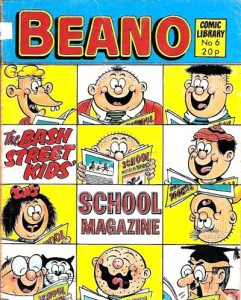The formative literature of my early years was a stack of cheaply printed comics with newsprint covers and goofy names that are puzzling to most Americans, myself included: The Beano, The Dandy, The Topper, The Beezer, Whizzer and Chips, Buster, Cor! Back in the 1960s and 1970s, these comics were churned out by the barrelful by the British publishers D.C. Thomson, Fleetway, and IPC. Most are gone now, but The Beano and The Dandy are still around, and some of the original characters endure as well.
I was happy about writing about these little-known comics until I read this. Apparently this particular genre of comics haven’t changed much since 1967. No cell phones! No video games! Hippie jokes! Way to rain on my nostalgia, dude! And the coup de grace:
Without a strong creator allowed to take charge and update the property with a new, modern vision, The Beano follows the same basic model as Archie Comics in the U.S.: the characters are just familiar four-color chess pieces to be moved around in the service of familiar jokes that lead to groans instead of laughs.
Feh! What’s wrong with that? Kids’ comics don’t have to be great literature. Sometimes they can be something dumb and funny that you read while sprawled across your bed eating candy.

Most of the characters in British comics were defined by a single trait carried to an extreme. Keyhole Kate spied on people through keyholes. Billy Whizz was really fast. Greedy Pigg was a gluttonous teacher who would go to extreme lengths to get something to eat. Chalky drew chalk objects that became real. Desperate Dan was an overgrown cowboy, a hilarious caricature of the British notion of Americans; he wore a vestigial gun, which he never drew, dined on cow pies (an enormous pie with a cow’s tail dangling out the side), and broke everything he touched because he didn’t know his own strength. It seems like all the creativity in these comics went into dreaming up the characters; once that was done, they went through their paces every week.
That didn’t bother me. Most of the stories were only a page or two long, and reading them was more like a short visit with a wacky friend than a trip through an actual storyline. I don’t remember individual stories, but I remember the characters very vividly. They are dancing around in my head as I am writing this.
British comics of that era were much edgier than their American counterparts, more Garbage Can Kids than Little Dot. The art was exaggerated, and the kids were horrible brats. Bully Beef and Chips was about a sadistic big kid who beat up a nerdy littler kid every week, and every week, the nerdy little kid got some clever revenge. Roger the Dodger, Minnie the Minx, and Beryl the Peril were bratty kids who tortured their parents and usually ended up on the wrong end of a slipper in the last panel. The Bash Street Kids contributed the useful and expressive phrase “pungent pong” (horrible smell) to my family’s lexicon. No one experienced deep thoughts or learned lifelong lessons in these comics, and that’s how we liked it.
Later on, I would get bored and move on to stories with more complexity, including the British girls’ comics Bunty and Judy and Mandy and Diana. But when I was six, a copy of The Beano, a bag of chocolates, and the absence of nagging adults was the recipe for pure bliss.
__________________
Update by Noah: For those who are wondering, Brigid has very kindly agreed to participate in our kids comics roundtable this week. She is too polite to mention all her other internet writing, so I will do it for her. She writes a column called Unbound at Robot 6; a fabulous manga link blog called (appropriately) Mangablog a kids comics linkblog at School Library Journal and goodness knows what else. So go read her other missives, and make her feel at home while she’s here, all right?

